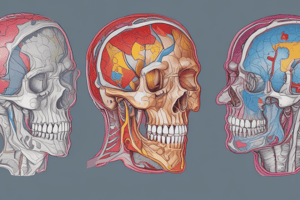Podcast
Questions and Answers
What is the primary mechanism by which a CT scan produces detailed cross-sectional images of the body?
What is the primary mechanism by which a CT scan produces detailed cross-sectional images of the body?
A CT scan uses an X-ray tube that rotates around the patient, capturing multiple images which are then compiled by a computer.
What are the two main types of CT scans, and how do they differ in image production?
What are the two main types of CT scans, and how do they differ in image production?
The two main types are single-slice CT, which produces one image at a time, and multi-slice CT, which produces images in rapid succession.
Discuss one major risk associated with CT scans and why it's a concern.
Discuss one major risk associated with CT scans and why it's a concern.
One major risk is radiation exposure, as CT scans involve higher doses of radiation compared to regular X-rays.
Explain the importance of patient preparation before undergoing a CT scan.
Explain the importance of patient preparation before undergoing a CT scan.
Identify a limitation of CT scans regarding their ability to differentiate between tissues and specify the patient group it may affect.
Identify a limitation of CT scans regarding their ability to differentiate between tissues and specify the patient group it may affect.
Flashcards are hidden until you start studying
Study Notes
Overview of CT Scan
- Definition: Computed Tomography (CT) scan is a diagnostic imaging tool that combines X-ray images taken from different angles and uses computer processing to create cross-sectional images of bones, organs, and soft tissues.
How It Works
-
Process:
- The patient lies on a table that slides into the CT scanner.
- An X-ray tube rotates around the patient, capturing multiple images.
- A computer compiles these images to create a detailed cross-section of the body.
-
Types:
- Single-slice CT: Produces one image at a time.
- Multi-slice CT: Produces images in rapid succession (more common today).
Uses
- Diagnostic Purposes:
- Detecting tumors or cysts.
- Assessing injuries to soft tissues, organs, and bones.
- Guiding procedures such as biopsies.
- Monitoring the effectiveness of treatments.
Advantages
- Provides detailed images of internal structures.
- Non-invasive and quick procedure.
- Can visualize complex anatomy.
Risks
- Radiation Exposure: Higher doses of radiation compared to regular X-rays.
- Allergic Reactions: Possible reactions to contrast materials used during the scan.
Preparation
-
Before the Scan:
- Patients may be required to fast for a few hours.
- Instructions may be given regarding the intake of contrast dye (if used).
-
During the Scan:
- Remain still and hold breath during image acquisition to avoid blurring.
Post-Procedure
- Minimal recovery time; most patients can resume normal activities.
- Results typically reported within days, depending on the urgency.
Limitations
- May not differentiate between certain types of tissues well.
- Not suitable for patients with certain allergies (to contrast materials) or pregnant women unless absolutely necessary.
Computed Tomography (CT) Scan
- A medical imaging technique combining X-ray images from multiple angles to create detailed cross-sections of the body.
- Uses computer processing to assemble these images providing a comprehensive view of bones, organs, and soft tissues.
How CT Scans Work
- Patients lie on a table that moves into the CT scanner.
- An X-ray tube rotates around the patient acquiring several images.
- A computer combines these images to produce detailed cross-sections.
- Two types of CT scans:
- Single-slice CT: Produces one image at a time.
- Multi-slice CT: Produces images in rapid succession (more common).
CT Scan Applications
- Diagnosing various conditions, including tumours and cysts.
- Assessing injuries to soft tissues, organs, and bones.
- Guiding procedures like biopsies.
- Monitoring treatment effectiveness.
Advantages of CT Scans
- Provide detailed images of internal structures.
- Non-invasive and relatively quick procedure.
- Capable of visualizing complex anatomy.
Potential Risks of CT Scans
- Radiation Exposure: CT scans involve higher radiation doses compared to standard X-rays.
- Allergic Reactions: Possible reactions to contrast materials, which are sometimes used during the scan.
CT Scan Preparation
- Before the Scan:
- Patients may require fasting for several hours.
- Specific instructions might be provided regarding the intake of contrast dye (if used).
- During the Scan:
- Remain still and hold your breath when image acquisition is occurring to avoid blurring.
Post-Procedure
- Minimal recovery time; patients can usually resume normal activities soon after the scan.
- Results are typically reported within a few days, depending on urgency.
CT Scan Limitations
- May not effectively differentiate between certain types of tissues.
- Not suitable for patients with certain allergies (to contrast materials) or pregnant women unless absolutely necessary.
Studying That Suits You
Use AI to generate personalized quizzes and flashcards to suit your learning preferences.




